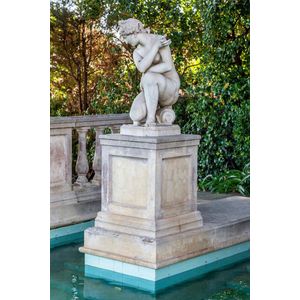Crouching Venus Carrara Marble Sculpture
A carrara marble figure of the crouching Venus, after the Hellenistic sculpture by Doidalsa, Italian 19th century 90 cm high, 34 cm wide, 46 cm long
You must be a subscriber, and be logged in to view price and dealer details.
Subscribe Now to view actual auction price for this item
When you subscribe, you have the option of setting the currency in which to display prices to $Au, $US, $NZ or Stg.
This item has been sold, and the description, image and price are for reference purposes only.
- Aphrodite / Venus - In Greek mythology, Aphrodite is the goddess of love, desire and beauty, whilst in Roman mythology she is called Venus.
- Carrara Marble - Carrara marble is a type of white or blue-grey marble quarried in the Carrara region of Tuscany, Italy. It is prized for its beauty, durability and the ease with which it can be worked. The marble has been used for thousands of years for sculptures and architectural details, and was particularly popular during the Renaissance period. Some of the most famous sculptures in the world, such as Michelangelo's David, were carved from Carrara marble. It is also widely used in the construction of buildings, floors, and countertops, both indoors and outdoors. This marble is known for its unique veining which gives it a distinctive look, and it's a popular choice for interior design, especially bathrooms and kitchens.
- Hellenistic - The Hellenistic period is a period in ancient Greek history
that began after the death of Alexander the Great in 323 BCE and lasted until
the Roman conquest of Greece in 146 BCE. It is named after the Greek word
"Hellenistic," which means "to imitate Greeks."
During the Hellenistic period, the Greek world expanded
beyond the boundaries of Greece and encompassed the territories conquered by
Alexander the Great, including Egypt, Persia, and parts of India. The period
was marked by a fusion of Greek culture with the cultures of these conquered
territories, resulting in a diverse and cosmopolitan society.
The art and architecture of the Hellenistic period were
marked by a new sense of realism and individuality. Artists and architects
experimented with new techniques and styles, and the incorporation of new
materials such as bronze and glass. A number of the best-known works of Greek sculpture belong to this period, including Laocoon and his Sons, Venus de Milo, and the Winged Victory of Samothrace.
This item has been included into following indexes:
